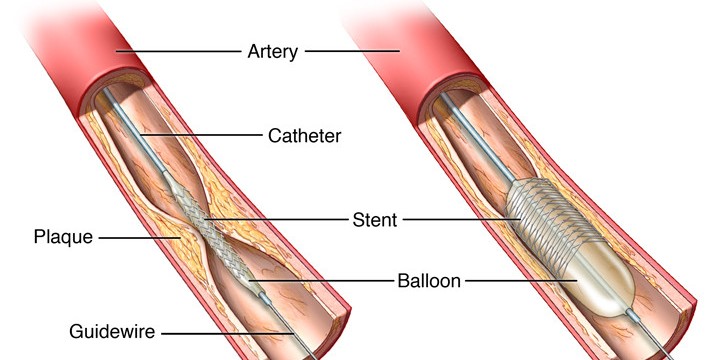ANGIOPLASTY WITH STENTING
WHAT IS CORONARY ANGIOPLASTY / PAMI?
When cholesterol gets deposited in the wall of your coronary arteries (called as plaque), it causes narrowing of the lumen of arteries. This can reduce blood flow to your heart and cause chest pain (angina) or heart attack (myocardial infarction). Coronary angioplasty, also called PTCA (Percutaneous Transluminal Coronary Angioplasty) is the procedure which opens blocked arteries (by tiny balloon & stent) and restores normal blood flow to your heart muscle. In emergency situation like, heart attack (myocardial infarction/STEMI), angioplasty should be done as soon as possible and it is called as PAMI (Primary Angioplasty in Myocardial Infarction).
HOW CORONARY ANGIOPLASTY IS DONE?
Angioplasty is not a major surgery, it can be done from the same puncture (in arm or groin) done for angiography. Patient remains fully awake throughout the procedure. Whole procedure is performed with the help of special x-ray machine in cardiac cath lab (cardiac catheterization laboratory). In this procedure, a thin, hollow tube called a catheter is inserted into a blood vessel from your arm or groin. The tube is threaded into your coronary arteries and tiny wire is advanced into the artery where the block is situated. The blocked artery is then opened by inflating a tiny balloon in it. Angioplasty is often combined with the placement of a stent. The whole procedure usually takes 30-60 minutes.
CORONARY STENT
A stent is a short, metal mesh tube that acts like a scaffold to help keep your artery open. Stent remains in the body permanently. There are two main types of stent:
- BMS – Bare metal stent or uncoated stent
- DES – Drug eluting stent or medicated stent; which is coated with special medication that reduces the risk of the artery becoming blocked again
There are certain stents which are made from special materials that get dissolved or be absorbed in the body. This type of stent disappears completely from the body after few months.
PRECAUTIONS AFTER ANGIOPLASTY & STENTING
You will usually remain hospitalized for one day while your heart is monitored and your medications are adjusted. You will normally be able to go home the day after the procedure. You will need to avoid heavy lifting, strenuous activities and driving for few days.
The most important thing is that you closely follow your doctor’s recommendations about your drugs, especially with blood-thinning medications such as Aspirin and clopidogrel or similar medications like Ticagrelor/Prasugrel. Those who have had stent placement will need a blood-thinning medication for a year or longer in some cases. If you have any doubts or if you need any surgery, talk to your cardiologist before stopping any of these medications.

